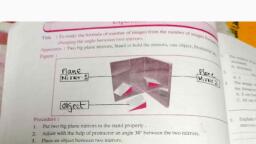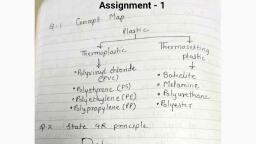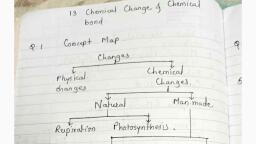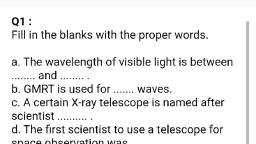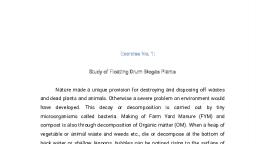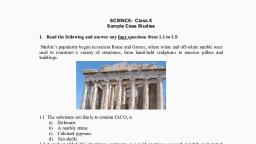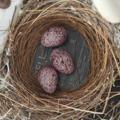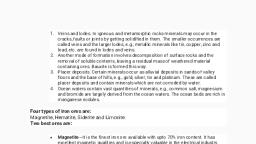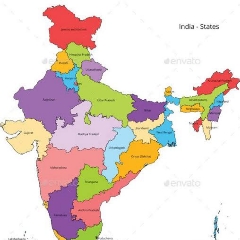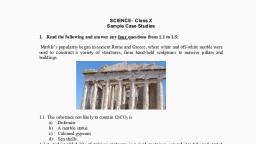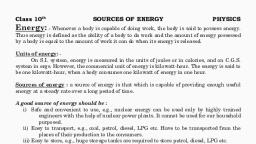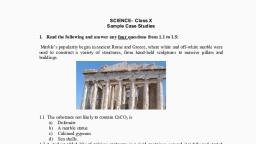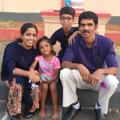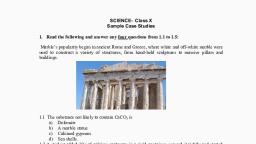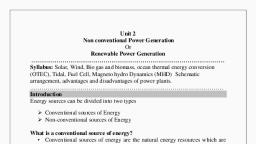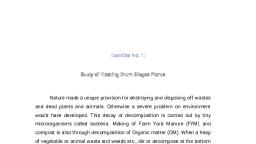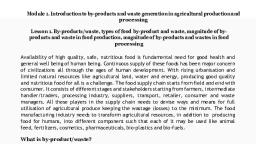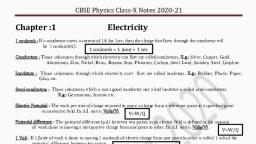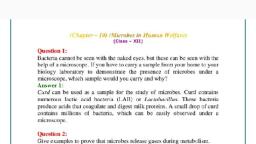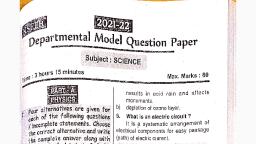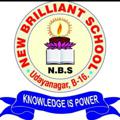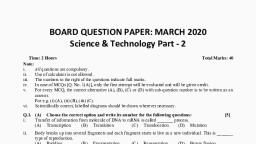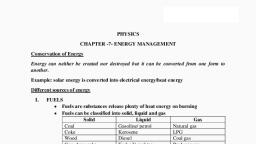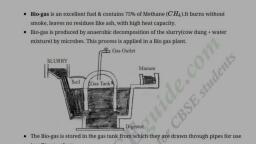Page 1 :
PROJECT BOOK - STANDARD IX : PART 1, , MODEL PROJECTS, Project 1, , Energy Transformations, , (Chapter 2), , Name of the student:, Name of the school: ., Standard: .--., , Roll no.: ., , Division, , Student's signature :, , Teacher's signature :|, , Aim: To study the various instances of transformation of energy seen in the surroundings., Introduction: There is a close relation between work and energy. A body possessing energy can do work. The, , energy possessed by a body due to its motion is called kinetic energy. It exists only in one form. The energy, possessed by a body due to its position or configuration is called potential energy. It exists in different, , forms. For example. potential energy associated with gravitational force is called gravitational potentüal, energy. Similarly, potential energy associated with electric force is called electric potential energy. Heat., sound. light, nuclear energy are different forms of energy. Energy can neither be created nor destroyed., , It can only be converted from one form into another., , Need of the project: Our every action involves energy transformation. Working of every machinedeice, appliance/instrument involves conversion of energy from one form into another. Energy transformation, use of energy sources and, an important role even in global warming. To become aware of the careful, , plays, , to study various energy transformations, this project is needed., , Methodology, , used, (1) A questionnaire is prepared to conduct a survey to find the gadgets/devices/appliances, (2) The questionnaire were given to five families and collected after two days., , in homes., , (3) Various events taking place in the surroundings were observed and noted., , (4) The information about energy transformations in the gadgets used in homes and the events taking place, in the surroundings was collected., , (5) The findings, , were, , tabulated, , Tubelight, , Ceiling fan, , Electric bell, , Mixer Grinder, , as, , shown in Observation Tables 1 and 2., , Television, , Microwave, , Washing machine, , Hair dryer, , Electric iron, , Electric motor, , Invertor, , Gas stove, , Gadgets/Devices in homes, , VIKAS SCIENCE AND TECHNOLOGY, , PROJECT, , BOOK:, , STANDARDS IX & x
Page 2 :
Cat j u m p i n g on a, , Fruit falling from a tree, , Collision, , Bird singing on a tree, , two, , between, , tree, , cars, , V di N, , Scooter riding, , Generator, , Electric pump, , Explosion of a firecracker, , Events taking place in the surroundings, , Observation:, Table 1: Energy transformations taking place in gadgets used in homes., Sr. No., , Energy Transformation, , Gadget/ Device, , Light (mainly), , and heat, , 1, , Tubelight, , Electric, , 2, , Ceiling fan, , Electric energy, , Kinetic energy and heat, , 3, , Television, , Electric energy, , Light, sound and heat, , 4, , Washing machine, , Electric energy, , Kinetic energy, sound and heat, , energy, , 5, , Hair dryer, , Electric energy, , Kinetic energy, sound and heat, , 6, , Electric iron, , Electric energy, , Heat, , Electric bell, , Electric energy, , S o u n d and heat, , 7, 8, , Mixer Grinder, , Electric energy, , 9, , Microwave, , 10, , Electric motor, , 11, , Invertoor, , Electric energy, Electric energy, Electric energy, , Kinetic energy. sound and heat, Heat, , Kinetic energ. heat and sound, , Chemical energy (charging), , Chemical energy, , 12, , Gas stove, , energy, , Chemical energy >, , Electric energy (when the invertor, Heat,, , light, , and sound, , is, , s, , ed)
Page 3 :
Table 2: Energy transformations, , taking place in various, , events., Energy Transformation, , Events, , Sr. No., 1, , A fruit falling from a tree, , Gravitational potential energy, , 2, , A bird singing, , Energy of the, , 3, , Collision between two vehicles, , Kinetic energy, , >, , 4, , A cat jumping on the branch, , Bioenergy, , Kinetic energy and gravitational potential energy, , bird, , (bioenergy), , Kinetic energy, », , Sound, , Heat and sound, , of a tree, 5, , A, , 6, , Explosion of a firecracker, , 7, , Electric pump drawing water, , generator, , used in, , a, , shop, , Chemical energy, , Electric energy, sound and heat, , Chemical energy, , Kinetic, , Electric energy >, , energy, sound,, , heat and, , Kinetic energy and gravitational potential, , from a well, 8, , Scooter riding, , light, energy, , Chemical energy, , Kinetic, , energy. heat and sound, , Inference : From Tables 1 and 2, we can infer that in domestic appliances used in everyday life and in many, , phenomena happening in our surroundings, energy transformations take place., Conclusion: Energy transformations occur everywhere and in every second in nature and it is an essential, , part of the universe., References, , https://en.wikipedia.org/wiki/Conservation_of _energy, , https://prezi.com/rsf-Ov2sxynv/energy-conversion-in-household-appliances/, , https://quizlet.com/12991 1315/energy-transformations-and-examples-flash-cards/, https://www.e-education.psu.edu/egee 102/node/1906, , https://study.com/academy/lesson/energy-transformation-definition-types-examples.html, https://www.google.co.in/search?q=pictures+of+energy+transformation+examples&, Multiple, , Choice Questions
Page 4 :
Project 2, , (Chapter 13), , Model of Biogas Plant, , 7, , Name of the student: ., , Name of the school:, , -, , Roll no., , Division: -, , Standard: ..., , Teacher's signature :|, Student's signature :, , Aim: To make, , a, , model, , : Any, , Introduction, , of a biogas plant, , and make, , substance which upon, , fuel. The fuels which, , we use, , day, , every, , Biogas, , is, , a, , renewable, , source, , produces, , non-renewable, , sources, , and is considered as an, waste, carbon dioxide. A rich organic, , Need, , of the, , industry, , play, of energy., , as a, , source, , are, , wood. coal, domestic gas, , and cheap s o u r c e of fuel in rural, Biogas is a clean, unpolluted, and the rest, about 55% to 60% methane gas, Biogas contains, used as a, plant which is dried and, is obtained from the biogas, , fertilizer., , Project: Fuels, , of energy, , of energy., ideal fuel., , areas, , is, , about the process of gas production, presentation in class, is known as a, a usable amount of energy, , combustion, , from, , petrol, diesel. etc., , a, , an, , important role in, , Use of, , our, , non-renewable, , daily, , sources, , lives., , They, , of energy, , are, , used in homes. transport, , causes, , and, , deforestation. destruction, , environmental imbalance., , oi, , lead to, animal habitats. All these, ecosystems and, earth. It is relatively clean. colourless. anc, the power to heal the, has, and, future, the, valuable information abou, Biogas is the fuel of, as it imparts, importance, utmost, of, of biogas is, this, odourless. Hence, , project, , biogas., , Balloon, , (Gas collector), Tube, Inlet for slurry, , - Nozzle, , Outlet for sludge, , Bottle of, mineral waler, , (Digester), Bunsenbunier, , Working model of biogas plant, , nna, , Tan n r . c A I T n ARD, , IX & X
Page 5 :
material in a day. Prepare the, model of a biogas plant. Collect the slurry, slurry which is the raw material to produce biogas. Feed the slurry in the digester ot the plant and keep, , Methodology, the system, , (1), , :, , Construct, , working, , a, , model, follow the, , undisturbed for one week. To prepare a, , given, , procedure, , Delow., , in the market. As the bottle is, mineral water which is available, the c o n t a i n e r so a s to, should not enter, transparent or ranslucent, paint it in black colour. Sunlight, tank. To insert the inlet pipe make, ensure good production of biogas. This bottle will act like a digester, mouth. Insert Uhe inlet pipe, distance from its, one hole near the neck of the container keeping s o m e, Close the mouth ol this pipe, without touching it., through this hole till it reaches up to the bottom, but, shorter than the, hole. Insert another pipe,, with a lid. Then at the side of the container make another, also. This pipe, this outlet pipe, Close the mouth of, vertical pipe. through this hole into the container., of the digester (plastic, Close the mouth, will act as a n outlet for the sludge produced in the process., Fix a balloon tightly, the help of glue., this lid insert o n e nozzle and fix it with, with a lid., , Take a, , b-litre container, , (bottle) of, , Through, , bottle), , will act as, to this nozzle. This balloon, Collect the, , (2), , slurry material,, slurry, , material. Mix the, Now feed this, , (3), , slurry, , which, , gas, , a, , or other, , be, , can, , collecto., , cow, , dung,, , material in the ratio of 1:1 with, , in the, , The organic, , digester., , garbage. green grass, material, water. This liquefied, , household, , in the, , matter, , slurry, , green plar, , is called, , slurry., , and, will start decomposing, , producing the biogas., (4), , Record the date when the, , (5), , Check for, , was created., , generator, , gas production every day., , takes a, longer, of biogas initially, the gas. The production, of, and, production, date, balloon will get inflated, Keep track of the, After 7 days, the, to, gas., week, produce, as o n e complete, time. It may take as long, , due to, , biogas., , of, , accumulation, , little, , Observations:, , (1) Slurry, , biogas plant, , filled in and, , (2) Gas started coming, , out on, , made, , ready, , on, , . . . ., , the beginning., of biogas is slow in, production, of, rate, The, (3), burn., out first does not, (4) The gas coming, burns., out after 7 days, (5) The gas coming, where there, Collect information, , of places (all, , Inferences/Conclusions, , : The, , over, , slurry, , is a, , mixture, , of the cattle, , in the, , acid, , forming, , The acid, , forming, , bacteria convert, , dung, , Biogas plants, , on, , in operation., , and water, which, , biogas digester,, , When no air is present, in the ratio of 1:1., act, bacteria which, bacteria and (2) gasifying, , (), , are, , Maharashtra), , two, , types of, , are, , mixed, , bacteria, , are, , together, formed., , the slurry,, , release, volatile acids and, and fats into the, proteins, carbohydrates,, , methane and, and convert them into, phase, in the previous, methane., acids produced, m o r e than, bacteria act on the, dioxide in biogas is, carbon, Gasifying, the, of, blue, the proportion, burns with a clean, dioxide. In the beginning,, is produced, it, , carbon dioxide., , carbon, , hence the gas, , when, After that,, does not burn., , enough, , methane, , flame., , 11, VIKAS, , SCIENCE, , AND, , TECHNOLOGY, , PROJECT, , B0OK, , STANDARDS, , IX & X
Page 6 :
PROJECT BOOK - STANDARD IX : PART 2, MODEL PROJECTS, , Project 1, , Hospital Waste Management, , (Chapter 9), , Name of the student:, Name of the school: ., Standard:.., , Division:., , Student's signature :, Aim, , To visit, , a, , Roll no., Teacher's signature, , nearby hospital, , and collect information about how waste is managed., , Introduction : The problem of solid waste management is becoming severe day by day. In urban areas, there, is a greater proportion of generated wastes. The most hazardous among this. is hospital waste. Since there, are many potentially dangerous items in the hospital wastes, therefore a special care has to be taken to, manage such a waste. Worldwide each and every hospital needs to follow certain set of rules before they, dispose their wastes., Objective : To understand the methods of disposal of hospital wastes., , MethodoloEy: Survey and interviews with hospital staff and internet surfing, Observations, (1) Biomedical waste may be solid or liquid. Most of these may be infectious., , (2) Infectious wastes are handled with utmost care. Such wastes include, (1) Discarded blood, (ii) Unwanted bacterial cultures and stocks, , (ii) Identifiable body parts which have been removed during surgeries., (iv) Other human or animal tissue, , (v) Used bandages and dressings, (vi) Discarded gloves, etc., (3) Leak-proof containers are used for storage of such matter. These containers, , are so tough that they can prevent brealkage during handling. Containers of, , (4) Sharps Sharps, , means, , contaminated and used, , or, , International symbol of, , biohazardous material, , biomedical waste are marked with a biohazard symbol., unused needles,, , scalpels., , lancets and other devices, used syringes, etc. Such sharp articles are stored, , in containers till the time of their disposal., (5) At some large hospitals there are private incinerators. In the incinerator,, biomedical waste is burnt. Incineration destroys pathogens and sharps. The, discarded body parts, etc. are converted into ash and thus do not remain, , recognizable., (6) Microwaves are used to carry out disinfection of the biomedical wastes., , A t times the bleaching powder or bleach solution is used for disinfecting such, , Containers used in hospitals, to store sharps, , waste. Depending upon the type of wastes, solutions of sodium hydroxide and, , other chemical disinfectants are used., 6) Treatment of waste by heating or by using alkaline digesters is also a common practice., , VIKAS, , SCIENCE AND TECHNOLOGY PROJECT, , BOOK: STANDARDS IX &X, , 23
Page 7 :
segregation of, guidelines for, latest, The, (9), , biomedical, , waste, , recommend, , the following, , IV tubes, etc., , catheters,, , soiled gloves,, incinerated., (without needles),, later, is, Syringes, it, hence, R e d Bag, h a z a r d o u s and, This is most, swabs with, coloured, bag., red, and cotton, , :, , Yellow, , Yellow, , Bag:, , human, , anatomical, , Cardboard, a, , bags, , waste,, , are, , box with, , a, , body parts., , Black, , puncture, , Glass, , :, , and, vials, ampules, , other, , (PPC): Needles, sharps,, , blades, , proof container., , Bags : Black bags, , are, , all disposed of, , body fluids, blood1 b, , be discardeglassware is to, , blue marking/sticker., , Container, White Puncture Proof, translucent, , coding, , bandages, for dressings,, , box with blue marking, , cardboard, , are, , colour, , used for, , non-biomedical wastes, , medicines, disposable, peels. leftovers, packaging of, , such, , as, , are, , disposed of in, , a, , stationery, vegetable and, , cartons,, items such as tea cups,, , sweeping, , kitchen waste, etc., accumulation, careful, , hand, , of biomedical waste a r e generation,, Steps, Biomedical Waste (Management, and disposal. In India, there is "The, treatment., transport, storage,, amended for the regulation of biomedical waste manager, Handling) Rules. 1998". This rule is further, waste disposal is, for a few large hospitals, in most of the smaller units and clinics, the, However,, in, , Conclusion:, , the management, , except, , a, , major problem. The dumping into water, , s o u r c e s or, , dumping the medical, , infections among people and animals., References, , Interviews, , with hospital staff, , https: //www.ncbi.nlm.nih.gov/pmc/articles/PMC3430187, , https ://en.wikipedia.org/wiki/Biomedicalwaste, , waste in landfills is cre
Page 8 :
(Chapter 15), , Brain, Evolution of Vertebrate, , Project 2, Name of the student:, Name, , of the school., , -, , Standard:.., , Roll no., , Division, , Student's signature :|, Aim To, , ---, , Teacher's signature, , collect iniormation, , about the evolution of the brain of vertebrates for the presentaion, , in, , uhe, , classroom., Introduction: The brain is the most important organ in the body of any antmal. It coordinates and conurOis, , all the, , vital activities for survival. As the evolution of different, , development, , or orain structure., , animal groups took place,, , In vertebrate series this change, , be, , can, , there was, , It is interesting, , seen., , gradual, , tO note this, , development., , Objective To understand the development of brain in different vertebrates., Methodology: Sketches for each brain were made. Observation of specimens., , Project Presentation:, (1), , Five, , preserved specimens, , of brains of shark,, , bony fish, frog, pigeon and, , rabbit, , were, , observed, whereas, , models were seen for brains of alligator and horse., , (2), , The structural differences between the different brains, , noted. Then every animal's mode of, , were, , locomotion was taken into account., (3) Sketches were made for each type of model/specimen that was observed., , (4) The, , main, , parts of the brain,, , i.e., , olfactory, , lobes. cerebrum, optic, , lobes,, , cerebellum and medulla, , taken into consideration. Each of these parts is concerned with a specific function., Observations All the brain models/specimens were observed carefully., , Bony físh, (trout), , Primitive fish, , (dogfish shark), , Amphibian, , (frog), , Brains of different vertebrates-I, , VIKAS SCIENCE AND, , TECHNOLOGY, , PROJECT B0OK, , STANDARDS, , IX, , &, , x, , were
Page 9 :
Bird, , Small mammal, , (pigeon), , Large mammal, , (rabbit), Brains of different, , Conclusion, 1) From the above, , regions,, , observations,, , the anterior is the, , Reptile, , (horse), , (alligator), , vertebrates-II, , it can be, , understood that each type of brain includes, three anatomical, forebrain, the middle one is the midbrain and, the, , posterior, , hindbrain., , most is the, , (2) Forebrain includes, , cerebellum, (3) Forebrain, , olfactory lobes and cerebrum. Midbrain shows, optic lobes while, oblongata. The medulla continues as the spinal cord., enlarged portion of the brain in almost all the vertebrates, but in, , and medulla, , is the, , i.e. in horse, brain shows, , mammals, , (4) The, , is due to, , brain of each, , great enlargement. Forebrain enlargement, complex behaviour and muscle control., , species reflects, , the demands of, , ), , as, , their, , sense, , enlarged optic, on, , of olfaction, , the, or, , lobes, , vision., , smell, , as, , the vision is, , The, is, , olfactory, important, , lobes, for, , an, , important, also, , are, , feeding, , developed, , coordination. Mammals, , animals, their brains, , beings, brain, , the cerebrum is, is, , that it, , cerebrum which shows that human, , cerebrum, , overlaps, , betngs, , well, , and in, , The bird and mammals show very well, , being intelligent, so well developed, , case of, , in, , higher animals, , information processing required by, , and habitat., 5) The fish brain shows, animals, more, depend, , hindbrain shows, , as, , all other, , are, , its mode of, , life, , sense in the, , water. The aquatic, fishes, and, amphibians, , in, developed, prey-predator interactions., , their locomotion, , are, , mammals., , like birds and, , also modified, , parts, , the most, , requires, , lot of, , accordingly., , motor, , In, , human, , in the brain. 85% of the, , human, , intelligent among, , all. But due, , Overgrown cerebrum the olfactory lobes are not easily visible and are small and less developed., , t
Page 10 :
2, , A), , 6, Bony Fish, , 4, 6, , 6, , (6, , )Olfactory lobe (2) Cerebrum (3), , Optic lobe, , Mammal, , Bird, , Reptile, , Amphibian, , 4), , Cerebellum, , 5, , Medulla, , (6) Spinal cord, , Basic structure of the brain of vertebrates, , References : Kenneth V. Kardong', , Vertebrates. Comparative Anatomy. Function and Evolution, , .Tata McGraw-Hill Edition 2006, https:, , //simple.wikipedia.org/wikiWertebrate_brain, , https:, , //academic.oup.com/icb/article/42/4/743/659098
